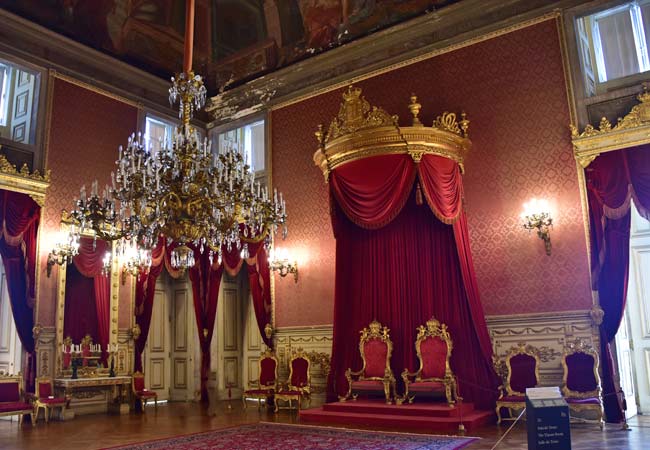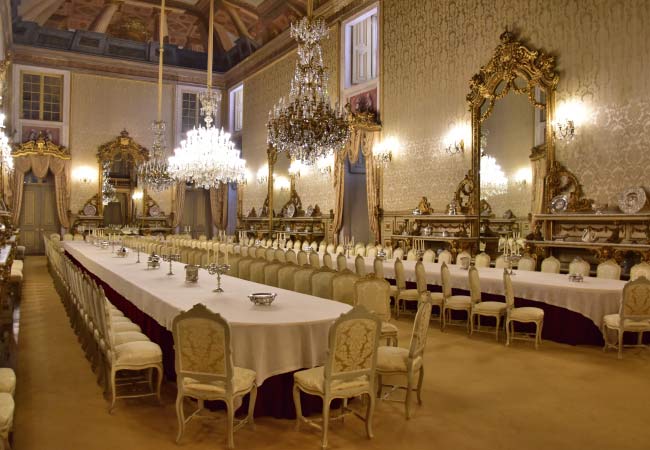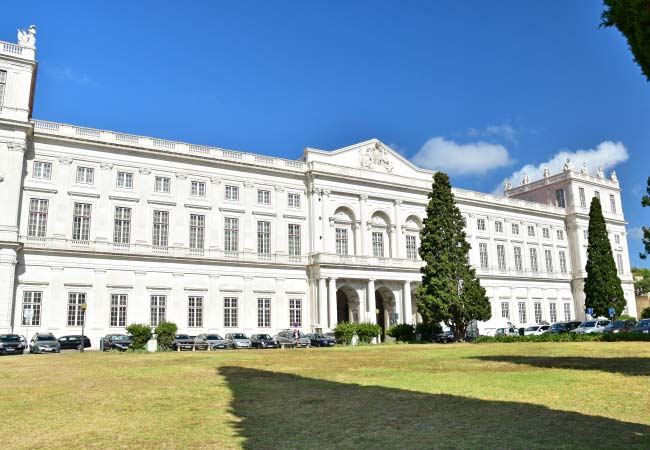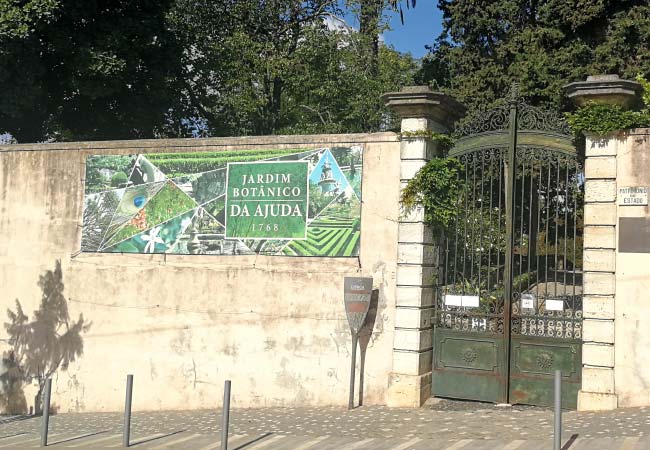LisbonLisboaPortugal.com
The best independent guide to Lisbon
LisbonLisboaPortugal.com
The best independent guide to Lisbon
Palácio Nacional da Ajuda; a tourist guide for 2025
High on a hill overlooking the Tagus, far from the central tourist throngs, the Palácio Nacional da Ajuda stands as Lisbon's great, overlooked royal monument. Its very existence is a direct consequence of Portugal's greatest national disaster: the 1755 Great Lisbon Earthquake. That catastrophe obliterated the royal family's riverside home, leaving the king with a profound claustrophobia, vowing never again to live within stone walls.
His solution was a vast, wooden palace built on the safe heights of Ajuda, known derisively as the "Royal Stall." This wooden complex, however, was destroyed by a devastating fire in 1794. The grand stone palace visitors see today was the second attempt. It only became the official royal residence in 1861, serving as the glittering stage for the monarchy's final decades before it was abruptly shut by the 1910 Revolution, leaving its contents perfectly preserved.
A visit today is a direct walk through the monarchy's final, glittering act. You explore sumptuous, silk-lined rooms where priceless furniture and staggering collections of art remain exactly as the last kings left them. The palace's new West Wing holds the Royal Treasure Museum, its fortress-like vaults protecting over a thousand pieces from the Portuguese Crown Jewels.
Highlights of the Palácio Nacional da Ajuda
The Throne Room (Sala do Trono) - This is the symbolic and political heart of the kingdom. Arguably the most impressive room in the palace, it is defined by its rich red silk walls and a large canopy sheltering the two royal thrones. The magnificent 1825 ceiling painting is an allegory of "Heroic Virtue," a political statement designed to reinforce the monarchy's authority to all who entered.

The Museu do Tesouro Real - Housed in the palace's new, contemporary West Wing, this is a state-of-the-art vault, one of the largest and most secure in the world. It permanently displays over a thousand priceless items from the Portuguese Crown Jewels. Key items include the royal insignia, rare Papal "Golden Roses," and dazzling gold and diamonds from Brazil.
The Great Dining Hall (Sala de Banquetes) - This magnificent and vast hall was designed for official state dinners and celebrations. It is not just a historical exhibit; the President of Portugal still uses this room today for official banquets to host visiting heads of state. Visitors can see the enormous dining table, impeccably set with the finest royal porcelain and silver.

Queen Maria Pia's Bedroom - Step into the private world of the monarchy in this masterpiece of 19th-century "Napoleon III style". The furniture, purchased in Paris, is made of wood lacquered to imitate fashionable black ebony. The centrepiece is the grand bed, raised on a platform under a canopy. This suite is unique as it is the only one in the palace that retains its original 19th-century carpets and ceiling paint.
Palácio Nacional da Ajuda Tourist Information
The Palácio Nacional da Ajuda is open from 10:00 to 18:00, with the last admission at 17:15. A typical visit to explore the palace rooms lasts between 90 minutes and two hours. If you plan to also visit the new Royal Treasure Museum, you should allow at least 3 hours for a combined visit.
Tickets for the Palace cost €15.00 for an adult, with a 50% discount for seniors (65 and over) and students (ages 13-24). Admission is free for children aged 12 and under.
Tickets for the separate Royal Treasure Museum cost €11.00 for an adult (ages 25-64), and €7.50 for youths (ages 7-24) and seniors (65+). Both the museum and place are free to enter with the Lisboa Card
The Palácio Nacional da Ajuda and the Museu do Tesouro Real are two separate attractions in the same complex. They have separate tickets and, most importantly, different closing days.
• The Palácio Nacional da Ajuda is CLOSED on Wednesdays.
• Museu do Tesouro Real open every day
Both are closed for national holidays; January 1, Easter Sunday, May 1, June 13, and December 25.
The palace is located on the Ajuda hilltop, 38.707, -9.198 (link to Google maps). The most direct method to reach it is by Uber/Bolt or bus. Lines 760 and 742 stop at Largo da Ajuda near the main façade, while lines 729 and 732 stop at Calçada da Ajuda. The walk from Belem (Jerónimos Monastery) is 1.5km, taking about 25 minutes due to the steep hill.

The Palácio da Ajuda, Lisbon
A Brief History of the Palácio da Ajuda
1755: The 1755 Great Lisbon Earthquake destroyed the royal family's riverside palace.
Post-1755: The King moved the court to a vast wooden complex on the Ajuda hilltop, known as the Real Barraca (Royal Stall).
1794: The wooden palace was completely destroyed by fire, though the library and chapel were saved.
1802: Construction began on a permanent Neoclassical stone palace, intended to be one of the largest in Europe.
1807 - 1821: The royal family fled to Brazil to escape Napoleon’s invasion.
1833: The civil war between liberals and absolutists, constriction haled again.
1834: King Pedro IV swore to the new Constitutional Charter in the Throne Room.
1861: King Luís I finally made the long-unfinished Ajuda Palace the official royal residence.
1910: The Fall of the Monarchy and the royal family fled into exile. The palace was shut down, its contents perfectly preserved and frozen in time.
1968: After 58 years of being closed to the public, the palace finally opened as a house-museum.
2022: The missing West Wing was finally completed with a contemporary façade to house the Royal Treasure Museum.
Key rooms in the Palácio da Ajuda
The Throne Room (Sala do Trono)
Located on the upper "Noble" floor, the Throne Room is the symbolic and political heart of the entire Kingdom. This is arguably the most impressive and historically significant room in the palace, designed for the monarchy's most solemn official acts.
The room is visually defined by its rich, red silk walls and a large, grand canopy that shelters the two royal thrones. But its true purpose is declared on the ceiling. Look up to see the magnificent allegorical painting Virtude Heróica (Heroic Virtue), completed in 1825. This was not simply decoration; it was a deliberate Neoclassical political statement. It was designed to surround the monarch with the abstract virtues of power, justice, and legitimacy, reinforcing their authority to all who entered the space.
More than any other room, this hall was the stage for the defining moment that shaped modern Portugal. After the devastating Liberal Wars (a civil war between 1828-1834), it was in this very room that the victorious liberal King D. Pedro IV formally swore to uphold the new Constitutional Charter of 1826. That single act transformed the monarchy, cementing the Palácio da Ajuda as the symbolic center of Portugal's new, limited constitutional government.
The Great Dining Hall (Sala de Banquetes)
This magnificent and vast hall, located on the "Noble" floor, was the glittering stage for the monarchy's public and diplomatic life. It was designed for official state dinners, lavish diplomatic banquets, and grand celebrations. This was where the Kingdom of Portugal projected its wealth and stability to the world, hosting foreign dignitaries and the highest members of the court.
The room is dominated by an enormous, long dining table, which you will see impeccably set with the finest royal porcelain and silver. It’s easy to imagine the scene during the palace's golden age, with the table arranged for an elaborate "à la française" dinner, where spectacular silver centrepieces, like pieces from the royal silver service, were arranged in symmetrical stages.
What makes this room so significant, however, is that it is not just a historical exhibit. It is a living monument. The Presidency of the Republic continues to use this very hall today for official state banquets, hosting visiting heads of state and foreign dignitaries.
The Audience Room (Sala de Audiências)
The Sala de Audiências was the third of the great state rooms, the formal space where the monarch dispatched official business. While the Throne Room was for grand ceremony, the Audience Room was the official "reception" room where King Luís I would meet with ministers, dignitaries, and ambassadors on Thursdays to conduct the business of the Kingdom.
The room is dominated by a magnificent set of six 17th-century Aubusson tapestries. These huge, intricate artworks depict episodes from the life of Alexander the Great, a classic decorative choice used to align the Portuguese monarchy with one of history's most powerful leaders.
As you look around, also seek out the large "Etruscan" Sèvres porcelain vase. This was a significant diplomatic gift from the French Third Republic to King Luís I in 1874, reinforcing this room's role as a center for international diplomacy.
Queen Maria Pia's Bedroom
After the grandeur of the public state rooms, this suite on the Ground Floor offers an intimate look into the private world of the monarchy. This is a masterpiece of 19th-century "Napoleon III style," which was the height of fashion at the time. Queen Maria Pia, known for her sophisticated taste, had all the furniture and silks purchased in Paris.
The furniture is all made of wood lacquered to imitate fashionable black ebony. The clear centrepiece is the grand bed, which is raised on a platform and protected by a canopy bearing the royal coat of arms. Also, look for the exquisite genuflectory (kneeler) of Italian origin, detailed with mother-of-pearl inlays.
This room holds a unique status: it and its adjacent chamber are the only ones in the entire palace to survive with their original 19th-century ceiling paint and carpets. Queen Maria Pia chose to preserve them, making this space a truly authentic time capsule of her personal taste.
The Royal Treasure Museum (Museu do Tesouro Real)
Housed in the palace's new, contemporary West Wing, the Royal Treasure Museum is a destination in its own right. This high-tech facility, was built to respectfully close the palace's 220-year-old architectural story and finally provide a permanent, secure home for the Portuguese Crown Jewels.
The museum itself is a state-of-the-art vault, considered one of the largest and most secure in the world. The visit is organised into 11 distinct sections, allowing you to see over a thousand priceless items from the Crown Jewels and the royal family's private collections.
While the entire collection is vast, there are several unmissable highlights.
• The Royal Insignia This section contains the most symbolic items of the monarchy. Here you can see the dazzling Crown, the royal Sceptres, and the two-remaining 19th-century royal Mantles, all essential pieces used in the coronation and formal rites of the Kingdom.
• Gold and Diamonds from Brazil This is a raw and powerful display of the wealth that flowed from the former colony. The collection includes a truly staggering gold nugget, said to be the second-largest in the world, as well as a dazzling, diamond-covered badge that showcases the incredible riches of the 18th century.
• Diplomatic Gifts This section reveals the monarchy's political and religious connections. The most important items are the two Papal Golden Roses. This was an exceptionally rare and prestigious honour given by the Pope; one of the roses on display was presented by Pope Gregory XVI in 1842.
• The Germain Silverware A significant portion of the famous 18th-century Germain silver dinner service is also on display in the museum. This provides a chance to see the intricate tureens, platters, and salt cellars of this world-renowned collection up close
The Ajuda Botanical Garden
Across the street from the palace, and often overlooked, is the tranquil Jardim Botânico da Ajuda. This is not just any park; it was Portugal's very first botanical garden, founded in 1768 by order of King D. José I, and built on the royal grounds. Its purpose was to serve as a "living museum" for studying thousands of plant species from around the world, and to help educate the young princes of the royal family.
While the palace is a monument to royal opulence, the garden is a quiet, structured world of its own. It is laid out in the formal Renaissance style, with two main terraces cut into the hillside. The upper terrace holds the main botanical collection and a tree garden with tropical flora. The lower terrace is a stunning ornamental garden, featuring intricate geometric designs made from box hedges.
The garden is often quiet and nearly empty, allowing you to explore in peace as peacocks roam freely among the visitors. The upper terrace also offers magnificent views over the Tagus, the 25 de Abril Bridge, and the Cristo Rei statue.
When you visit, there are two unmissable highlights:
The Central Fountain (Fonte das 40 Bicas) Located in the center of the lower terrace, this is an 18th-century Baroque masterpiece. Look closely at its intricate carvings of serpents, winged fish, seahorses, and mythical figures. The Dragon Tree (Dragoeiro) This is the oldest and most famous resident of the garden. This Dracaena draco, originally from the island of Madeira, is estimated to be about 400 years old.

Palacio da Ajuda, Lisbon Details
Though the Palácio da Ajuda is expansive and impressive, the royal residence did not fulfill the original plans drawn up in 1787. The initial design envisioned a palace three times the current size, with the main entrance facing south towards the Tejo Estuary and royal gardens leading down to the estuary's banks.
The first royal residence constructed in Ajuda was made entirely of tents and wooden structures. This temporary setup was due to King José I's fear of stone buildings after the destruction of the mighty Palácio Ribeira in the 1755 earthquake. Ajuda was selected for its elevation, making it safe from the tsunami that flooded Lisbon after the earthquake.
The wooden and tent complex burned down nine years after its founding, leading to the design of a stone structure in 1787. However, the construction of the Palácio da Ajuda faced numerous delays due to economic and political strife in Portugal, and it only became the official residence of the Portuguese royal court 150 years later.
The palace's extended building period allowed various architects to influence its design, resulting in a unique blend of styles with a predominant neoclassical influence.
The first Portuguese king to make the Palácio da Ajuda his royal residence was Luís I, who ruled from 11 November 1861 to 19 October 1889. The palace remained the official residence of the King of Portugal until the Revolution of 1910.
Architectural Marvels of the Palácio da Ajuda
Exterior
The Palácio da Ajuda is one of Lisbon's earliest neoclassical buildings, characterised by its imposing rectangular structure with an incomplete western wing. The eastern façade, the main entrance, is a magnificent display of symmetry with a central tympanum flanked by two towers.
Tuscan-Ionic columns and Roman arch windows add to its grandeur, while the central courtyard, paved with Portuguese calçada in geometric designs, offers a glimpse into the palace's intricate design.
Interior
The palace interiors are a treasure trove of art and history, meticulously designed during King Luís I's reign. As you enter, the Sala dos Archeiros (Archer's Hall) greets you with its golden metal shields and military victory paintings. The Sala das Tapeçarias Espanholas (Spanish Tapestry Hall) showcases eight exquisite Spanish tapestries, creating a regal atmosphere.
Other notable rooms include the Sala de Música (Music Room), adorned with pink silk walls and a grand oak fireplace, and the Jardim de Inverno (Winter Garden), a serene space with marble and agate finishes, featuring a Carrara marble fountain surrounded by bronze cranes.
Discover more of Lisbon with our most popular guides
If you've found our content valuable, we'd welcome your support.
The digital publishing landscape has evolved significantly. As a small independent publisher, we face growing challenges. Search engines increasingly favour paid content over organic results, while AI-generated content often reproduces original work without attribution.
To support our work, please consider bookmarking this page (press Ctrl + D) for quick access. If you find an article helpful, we'd be grateful if you'd share it with friends on social media.
For specific questions, please see our Reddit community at r/LisbonPortugalTravel.
Should you notice any outdated or incorrect information, please contact us at [email protected]
Thank you for helping us continue to provide valuable content in an increasingly challenging digital environment.
A complete list of all of our Lisbon articles
If you've found our content valuable, we'd welcome your support.
The digital publishing landscape has evolved significantly. As a small independent publisher, we face growing challenges. Search engines increasingly favour paid content over organic results, while AI-generated content often reproduces original work without attribution.
To support our work, please consider bookmarking this page (press Ctrl + D) for quick access. If you find an article helpful, we'd be grateful if you'd share it with friends on social media.
For specific questions, please see our Reddit community at r/LisbonPortugalTravel.
Should you notice any outdated or incorrect information, please contact us at [email protected]
Thank you for helping us continue to provide valuable content in an increasingly challenging digital environment.































